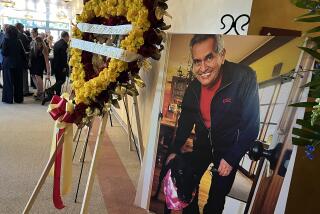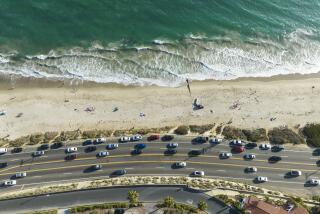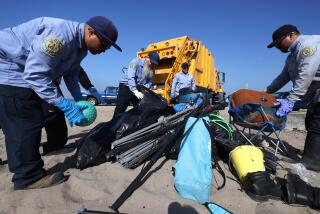Gilbert Vargas died in the line of duty
Los Angeles Times
Gilbert Vargas had a big personality. There wasn’t anyone he couldn’t or wouldn’t talk to, particularly about his passions: his daughters and his Pomeranian pup, Cuco.
“It was my dog, but it became his,” said his eldest daughter, Grecia Vargas. “He’s one of those persons who made an impact on everyone’s lives.”
Vargas, 50, was operating a backhoe on a city public works project in Pacific Palisades on March 14 when the U-shaped trench he was working on caved in. Vargas was buried chest-high in dirt in the 15-foot deep pit. Another worker sank nearly up to his hips.
After 1 1/2 hours, the Fire Department managed to extricate the second worker. Vargas died of multiple traumatic injuries, the coroner said. The injuries may have included suffocation. Cal/OSHA is investigating. Vargas died serving the public. The Temescal Canyon project that he was working on is part of a $50-million city program, funded by voter-approved bonds, to clean up Santa Monica Bay.
Specifically, Vargas was helping to divert fecal bacteria-laden runoff that now dumps directly into the surf zone at Will Rogers State Beach. This is the stuff that periodically closes the beaches and raises the risk of stomach flu, sinus infections and other maladies for millions of beach visitors in L.A. County each year. The runoff will either be treated at an underground tank and used for irrigation or sent to the Hyperion Treatment Plant near LAX.
“These are projects to clean up the environment and protect public health,” said Mark Gold, former president of Heal the Bay and associate director of UCLA’s Institute of the Environment and Sustainability. “We take them for granted until a tragedy of this magnitude occurs.”
Vargas’ death touched off the usual information clampdown that arises in L.A. when even a whisper of litigation is in the air. I visited the Covina headquarters of Los Angeles Engineering, which was awarded $8 million by the city to build the Temescal Canyon project. But no one would come to the front office and talk to me. Citing the pending investigation, city officials also declined to speak about the accident or about Vargas. An unidentified hard hat at the job site said no one would have any “comment” and shooed me away.
We’re a country that venerates work but not workers. We turn out to protest trees being knocked down, or grasslands being mowed over. But we don’t know and don’t seem to care how many people gave their lives building our bridges, freeways and infrastructure, the world we actually live in day-to-day.
Construction is a dangerous business. Of the 4,609 worker deaths nationally in 2011, 721, or nearly one in six, happened during construction, according to the federal Bureau of Labor Statistics. By way of comparison, 125 law enforcement officers that year died in the performance of their duties, the FBI said.
Trenching is one of the dicier parts of a risky profession, Peter Melton, a spokesman for Cal/OSHA, told me.
“Any time you excavate the ground it’s dangerous,” said Luis Robles, secretary of Laborers Local 300, which represented Vargas. “You don’t know if you’re going to hit a water line or the ground is going to give way.”
Two years before the Vargas accident, a 25-year-old man died after being buried during a trench cave-in, coincidentally also in the Palisades. McGrath Contracting of Van Nuys was fined $77,000 by Cal/OSHA, which found that the walls of the L-shaped trench he was working in had not been properly buttressed. McGrath is appealing the penalties.
Los Angeles Engineering appears to have a clean safety record. Robles said he was unaware of any complaints about workplace safety.
Vargas’ death rippled outward through his relatives, co-workers and first responders. Family members were at the scene during the nine-hour effort to free his body — what the L.A. Fire Department, in its news release, called the “dolorous recovery.” Ninety firefighters were assigned to the operation. Rescuers had to install emergency shoring to keep the trench from collapsing once again.
I can only imagine how deeply shaken all who witnessed it were by this calamity. Crisis counselors from the mayor’s office were on site, and the union later sent in specialists to help workers get through it . A couple of co-workers who saw the whole thing are having a tough time, a union official said.
Vargas, a Chino resident who came from Chihuahua, Mexico, decades ago, had worked construction in many Southern California cities, his daughter said. (Don’t bother with the emails, he was a legal immigrant.) From time to time, he traveled back to Chihuahua to visit his mother and sister. Otherwise, his family was his universe.
A week before the accident, he summoned his extended clan, including a sister, brother and cousin, to a Sunday barbecue. It was not a holiday, and no one was having a birthday.
They asked him, “What are we celebrating?”
“It’s just a family day,” he replied. Vargas in some mysterious way arranged to say his goodbyes.
More to Read
Sign up for Essential California
The most important California stories and recommendations in your inbox every morning.
You may occasionally receive promotional content from the Los Angeles Times.










